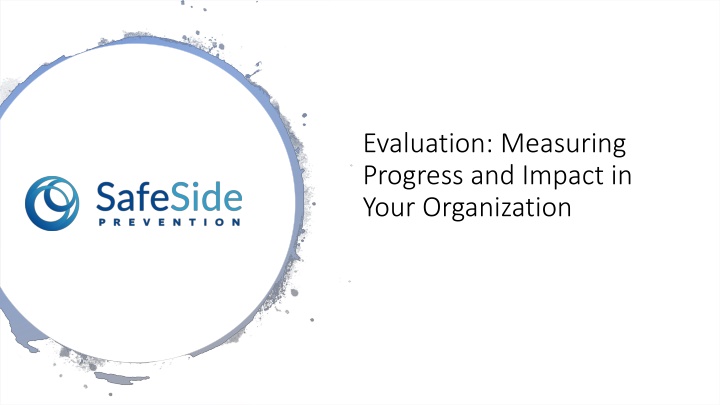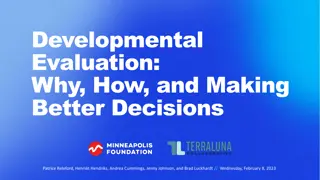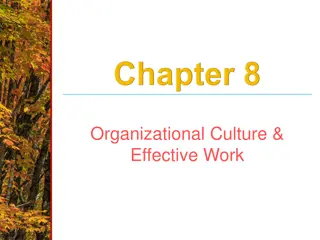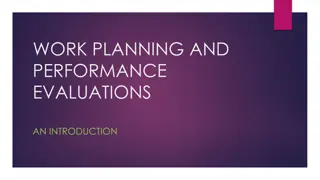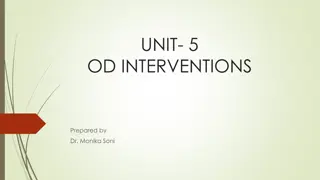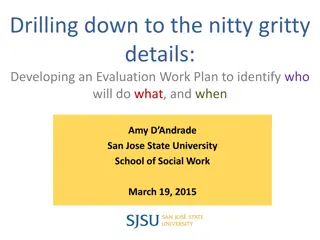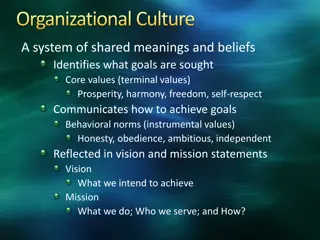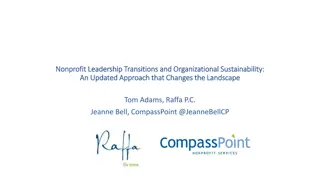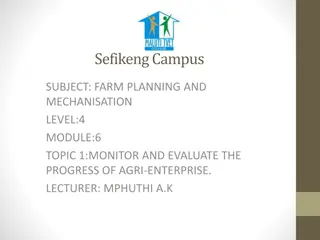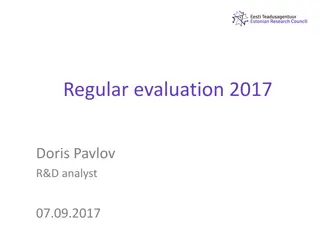Effective Evaluation Strategies for Organizational Progress and Impact
Learn how evaluation plays a crucial role in measuring progress and impact within organizations. Explore the importance of formative and summative evaluation, along with a detailed approach to clarify evaluation questions and reduce uncertainty. Discover key principles, metrics, sample questions, and metrics to address uncertainties effectively.
Download Presentation

Please find below an Image/Link to download the presentation.
The content on the website is provided AS IS for your information and personal use only. It may not be sold, licensed, or shared on other websites without obtaining consent from the author.If you encounter any issues during the download, it is possible that the publisher has removed the file from their server.
You are allowed to download the files provided on this website for personal or commercial use, subject to the condition that they are used lawfully. All files are the property of their respective owners.
The content on the website is provided AS IS for your information and personal use only. It may not be sold, licensed, or shared on other websites without obtaining consent from the author.
E N D
Presentation Transcript
Evaluation: Measuring Progress and Impact in Your Organization
Reaching your Goals Evaluation is designed to reduce uncertainty around key decisions and to be actionable Formative evaluation: Targets key areas of uncertainty to inform roll out Summative evaluation: Describes overall progress and impact at key milestones
Our Approach AIM: Clarify evaluation questions/decision where there is uncertainty Define decisions and stakeholders Identify variables that matter Identify and describe uncertainty ACT: Determine actions based on new learning ASSESS: Select and apply targeted measurements Implement learning based on new learning Focus on strengthening progress or impact Measure high-value uncertainties in economical ways Preference for available measures and data points ANALYZE: Evaluate what was learned against the targeted question Qualitative and quantitative data points Reduce uncertainty around identified questions
Metrics are organizationally meaningful and support key communications and desired change. Key Principles Existing data sources are leveraged (e.g., existing records, client and family satisfaction) and supplemented with new measures where needed. Domains to Consider Level 1: Workforce development/training experience Level 2: Workforce practice and behavior change Level 4: Level 3: Client experience Organizational culture change
Sample Questions and Metrics Question/Decision Do peers need additional supports to implement the SafeSide Framework in their work? Should expectations for on-going learning be established? If so, what? (Office Hours participation, refreshers per year etc.?) Questions to Reduce Uncertainty Do peers who complete SafeSide training find it applicable and transferrable to their role? Metrics to Address Question % of peers responding Strongly Agree or Agree on Learning Transfer Items (Post- Training Evaluation) % of clients who screen positive for suicide risk that have a contingency plan (electronic record) % of clients who have a documented follow up contact confirming referral was completed (electronic record) Average response on each Learning Transfer Item for members of the local cultural group vs. average response within the organization Focus group inquiry of cultural group regarding experience of training Are staff changing their practice with clients after attending initial video- guided learning? Are additional supports or adjustments needed to ensure training is inclusive of local cultural groups? Are participants from the cultural group of focus responding differently to the post-training evaluations than participants as a whole?
Sample Evaluation and Roll Out Timeline Participation in Office Hours, Updates/ Refreshers Soft Launch Post-Training Evaluation Pre-Workshop Leadership Survey Creates momentum and buy-in Changes pre-post from soft launch Indicator of workforce engagement in continued learning and application of SafeSide Framework Drives workshop agenda Additional information regarding uncertainty to guide decisions in roll out Identifies areas of uncertainty or need On-going Learning Soft Launch Leadership Kick- Off Workshop Full Roll Out Understand perspective of direct workers Measures knowledge, self-efficacy, and perceived transferability of content to roles Explore areas of uncertainty Predictive of behavior change Soft Launch Pre-Training Survey Post-Training Evaluations
